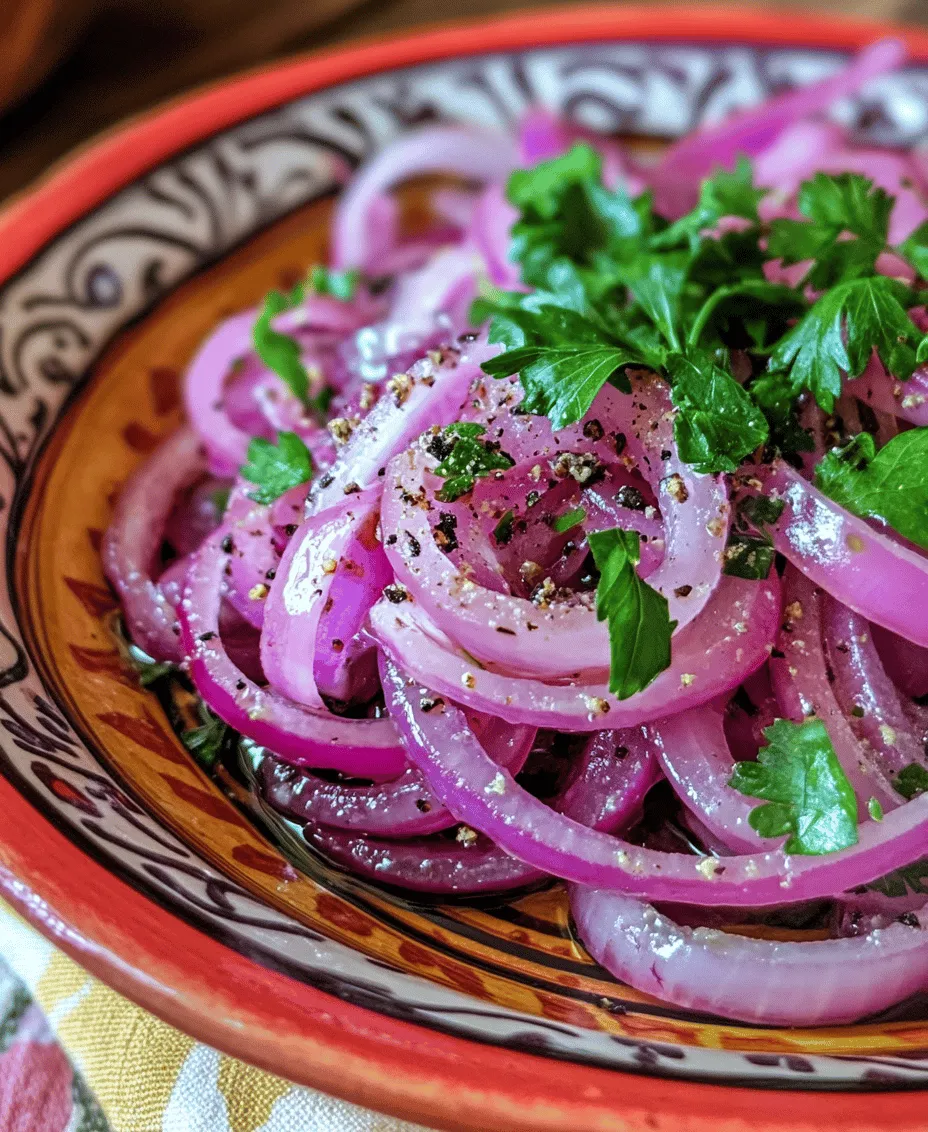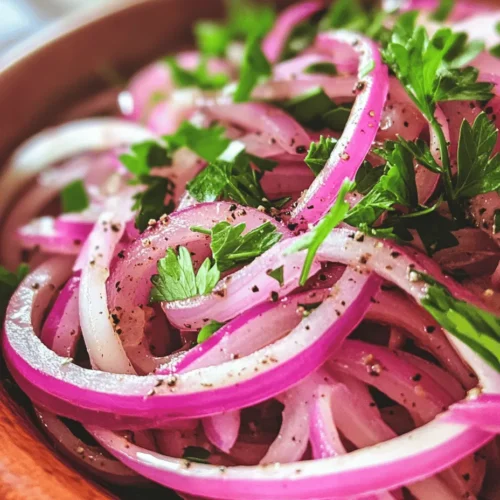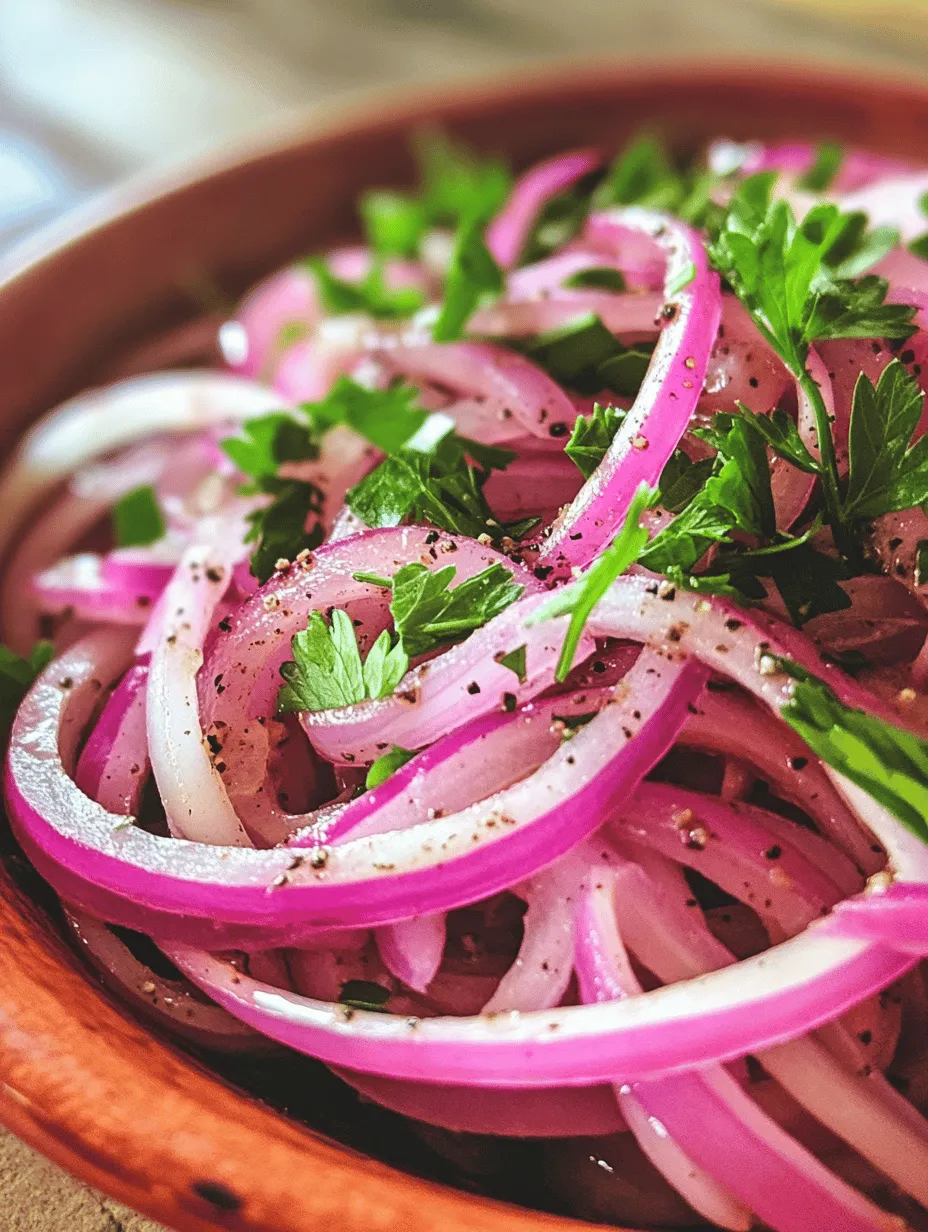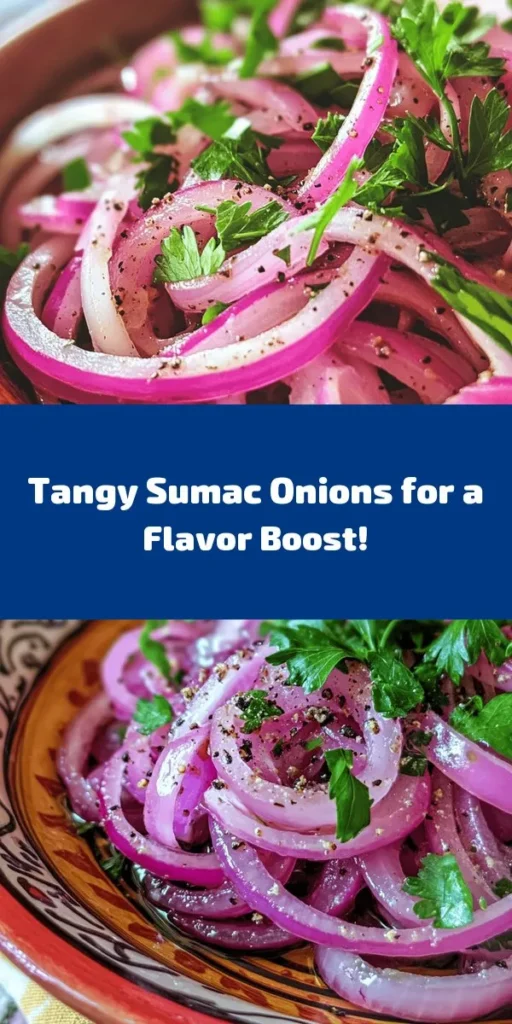In the world of culinary delights, few ingredients can elevate a dish quite like sumac. This Middle Eastern spice, with its tangy and citrusy flavor profile, adds a unique twist to various recipes. One such delightful dish is Sumac Onions, a simple yet flavorful preparation that can enhance salads, grilled meats, and wraps. In this article, we will explore the beauty of sumac onions, including their health benefits, preparation steps, and the perfect occasions to serve them.
Understanding Sumac
The Essence of Sumac in Cooking
Sumac is a spice that has been cherished in Middle Eastern cuisine for centuries. Derived from the dried and ground berries of the sumac plant, this vibrant red spice boasts a tart, lemony flavor that can invigorate a wide array of dishes. In cooking, sumac serves as a versatile ingredient that can be sprinkled over salads, meats, and even seafood, providing a zesty kick that brightens up the overall taste profile. Its unique flavor makes it a staple in dishes like fattoush, za’atar, and various marinades.
The popularity of sumac has transcended geographical boundaries, finding its way into various global cuisines. In Mediterranean and North African dishes, sumac is often used to season grilled meats or as a finishing touch on dips like hummus. This spice also pairs beautifully with roasted vegetables, lending a refreshing contrast to their natural sweetness.
Nutritional Benefits of Sumac
Beyond its culinary uses, sumac offers a plethora of health benefits. Rich in antioxidants, this spice can help combat oxidative stress in the body. Antioxidants play a crucial role in neutralizing harmful free radicals, thus supporting overall health and reducing the risk of chronic diseases. Furthermore, sumac has been linked to anti-inflammatory properties, making it a valuable addition to a balanced diet.
In addition to its antioxidant capabilities, sumac can support digestive health. Traditionally, it has been used to alleviate digestive discomfort and improve gut function. By incorporating sumac into your meals, you not only enhance flavor but also contribute positively to your well-being.
Ingredients Overview
Key Ingredients for Sumac Onions
The beauty of Sumac Onions lies in its simplicity, relying on a few key ingredients that come together to create a delightful dish. The primary components include:
1. Red Onions: The foundation of this recipe, red onions are known for their mild flavor and vibrant color. They add both sweetness and a slight sharpness that complements the tangy sumac.
2. Sumac: The star of the dish, sumac delivers its signature citrusy flavor, transforming ordinary onions into a zesty topping or side dish.
3. Olive Oil: A staple in Mediterranean cuisine, good quality olive oil adds richness and depth to the dish. It helps to mellow the sharpness of the onions while ensuring that the flavors meld beautifully.
4. Vinegar or Lemon Juice: The acidity from vinegar or lemon juice plays a crucial role in balancing the dish. It enhances the overall flavor profile, making the sumac onions a bright and lively addition to any meal.
The Role of Red Onions in the Recipe
Red onions are particularly well-suited for this dish due to their natural sweetness and vibrant color. When prepared correctly, they provide a wonderful crunch and a slight bite that complements the tanginess of sumac. Their striking hue also adds visual appeal, making Sumac Onions as beautiful as they are tasty.
In terms of health benefits, red onions are rich in vitamins and minerals. They contain high levels of vitamin C, which is essential for immune function, and they provide flavonoids, which have been shown to offer anti-inflammatory and antioxidant properties.
Benefits of Olive Oil and Its Flavor Contribution
Olive oil is more than just a cooking fat; it’s a cornerstone of healthy Mediterranean diets. Incorporating extra virgin olive oil into your Sumac Onions not only enhances the flavor but also contributes heart-healthy fats. This oil is known for its anti-inflammatory properties and has been linked to a reduced risk of heart disease.
The quality of olive oil matters, so opt for high-quality extra virgin olive oil that has a robust flavor. Its fruity notes will elevate the overall dish, creating a harmonious balance with the tartness of the sumac and the sweetness of the onions.
Understanding the Significance of Vinegar or Lemon Juice
Vinegar or lemon juice acts as a natural preservative and flavor enhancer in the Sumac Onions recipe. The acidity from either ingredient cuts through the richness of the olive oil, bringing a refreshing brightness to the dish. It also helps to soften the raw onions, making them less pungent and more palatable.
When choosing between vinegar and lemon juice, consider the flavor profile you want to achieve. A splash of red wine vinegar can introduce a complex depth, while fresh lemon juice adds a bright and zesty finish. Both options are excellent, depending on your personal preference.
Step-by-Step Preparation of Sumac Onions
Preparing the Onions
The first step in crafting the perfect Sumac Onions is preparing the onions. Start by selecting fresh red onions, as their quality will directly impact the flavor of the final dish.
Importance of Salting Onions: Before you begin slicing, it’s essential to understand the role of salting the onions. Once sliced, sprinkle a generous pinch of salt over the onions. This step helps to draw out excess moisture and reduces their sharpness. Allow the onions to sit for about 10-15 minutes; this process will result in softer, more flavorful onions that blend seamlessly with the other ingredients.
Tips for Slicing Onions Effectively: When slicing the onions, aim for thin, even slices. A sharp knife is crucial for achieving clean cuts without crushing the onion cells. If you’re sensitive to onion fumes, consider chilling the onions in the refrigerator before slicing, as this can help minimize tears.
Dressing the Onions
Once your onions are sliced and salted, it’s time to dress them with the other key ingredients. You’ll want to combine the sliced onions with sumac, olive oil, and your choice of vinegar or lemon juice.
Combining Ingredients for Optimal Flavor: In a mixing bowl, add the salted onion slices. Drizzle in a couple of tablespoons of olive oil, followed by a generous sprinkle of sumac. Depending on your taste preference, you can start with 1-2 teaspoons of sumac and adjust according to your liking. Add a splash of vinegar or a squeeze of lemon juice to the bowl, and give everything a gentle toss to ensure the onions are well-coated.
How to Achieve the Perfect Balance of Acidity and Seasoning: The key to Sumac Onions is striking the right balance between the tartness of the sumac, the richness of the olive oil, and the acidity from the vinegar or lemon juice. Taste the mixture as you go, adjusting the seasoning to suit your palate. If you find it too tangy, a drizzle of honey can help mellow the acidity without overpowering the dish.
Marinating for Maximum Flavor
After dressing the onions, allow them to marinate for at least 30 minutes before serving. This resting period is crucial, as it allows the flavors to meld and the onions to soften further. If time permits, marinating for several hours or even overnight can enhance the taste, making the sumac’s citrusy notes more pronounced.
The marination process also makes the onions more digestible, as the vinegar or lemon juice helps break down their harsh rawness. This makes Sumac Onions an excellent choice for gatherings, as they can be prepared ahead of time and served chilled or at room temperature.
By following these steps, you will create a vibrant and zesty dish that highlights the beauty of sumac and enhances a variety of meals. Whether served as a side, a topping, or a salad ingredient, Sumac Onions are sure to impress with their delightful flavor and health benefits.

The Science Behind Marination
Marination is not just a cooking technique; it’s a process that fundamentally alters the food’s taste and texture. When onions are marinated with sumac, the acidic properties of the sumac interact with the onions in a way that enhances their natural sweetness while simultaneously adding a zesty, tangy flavor. This interaction occurs at the cellular level: the acid begins to break down the cell walls of the onions, which allows for deeper flavor penetration.
The marination process also affects the texture of the onions. As they sit in the marinade, they soften slightly, making them more palatable and enjoyable to eat raw. This is particularly important for dishes where the crunchiness of fresh onions might overpower other flavors. The right marination time can transform sharp, pungent raw onions into a milder, more approachable condiment that complements a variety of dishes.
Serving Suggestions for Sumac Onions
Sumac onions are incredibly versatile and can enhance a wide range of meals. Here are some creative ways to incorporate them into your dining experiences:
Pairing with Grilled Meats or Fish
One of the most popular ways to serve sumac onions is alongside grilled meats or fish. The tangy flavor of the sumac, combined with the sweetness of the marinated onions, provides a refreshing contrast to the smoky, savory notes of grilled proteins. Try serving them with grilled chicken thighs marinated in lemon and herbs, or alongside a piece of salmon brushed with olive oil and sea salt. The brightness of the sumac onions elevates the entire meal, adding both color and flavor.
Incorporating into Salads and Wraps
Sumac onions can add a delightful crunch and zest to salads and wraps. Toss them into a fresh tabbouleh salad, where they will complement the parsley, tomatoes, and bulgur wheat beautifully. Alternatively, layer them in a wrap with grilled vegetables, hummus, and your choice of protein for a filling and nutritious meal. The acidity of the onions can cut through the richness of ingredients like creamy avocado or tahini, making each bite more dynamic.
Sumac Onions as a Side Dish
Serving sumac onions as a side dish is another excellent option. Their vibrant color and unique flavor profile can enliven a simple meal. Pair them with rice or couscous, allowing the onions to bring a fresh twist to traditional grain dishes. You can also serve them alongside roasted vegetables or flatbreads for a delightful mezze platter. Their role as a condiment is pivotal; they can brighten up any dish and transform it into something special.
Culinary Tips for Perfecting Sumac Onions
To ensure your sumac onions are flavorful and well-prepared, consider the following culinary tips:
Common Mistakes to Avoid
One of the most common mistakes when preparing sumac onions is misjudging the seasoning. Sumac has a tangy flavor, but it should complement, not overpower, the dish. Start with a small amount, taste, and adjust as necessary. Additionally, be mindful of the marination time. While a few hours can be sufficient, letting the onions sit overnight can yield even better results, allowing the flavors to meld together more fully.
Timing for Marination and Serving
Timing is crucial in marination. Ideally, allow the onions to marinate for at least 30 minutes, as this is the minimum time needed for the flavors to penetrate the onions effectively. However, for maximum flavor, aim for 2 to 4 hours, or even overnight if you have the time. Just be careful not to let them sit too long, as the onions can become overly soft and lose their appealing crunch.
Customizing Your Sumac Onions
Personalizing your sumac onions can elevate them to new heights. Consider adding spices or herbs such as fresh mint, parsley, or even a pinch of cayenne pepper for a kick. Experiment with different types of onions as well; red onions provide a milder flavor while white onions offer a sharper bite. Each variety brings its own unique characteristics, allowing you to tailor the dish to your preferences.
Cultural Significance of Sumac Onions
Understanding the cultural significance of sumac onions can deepen your appreciation for this dish. Sumac has been a staple in Middle Eastern cuisine for centuries, celebrated for its tartness and vibrant color. The use of sumac in dishes reflects the region’s agricultural history and the importance of herbs and spices in traditional cooking.
In many Middle Eastern cultures, sumac onions are enjoyed alongside kebabs and grilled meats, often served in a communal style where diners can customize their plates. This tradition emphasizes the importance of sharing and communal dining, where flavors meld and enhance the overall dining experience. The dish is not merely a condiment; it represents a cultural connection to family, tradition, and the rich culinary history of the region.
Conclusion
Sumac onions are more than just a simple side dish; they embody a blend of flavors and cultural significance that can enrich any meal. By understanding the preparation process and the ingredients involved, home cooks can easily incorporate this vibrant dish into their culinary repertoire. Whether served alongside grilled meats, tossed in salads, or enjoyed on their own, sumac onions are a testament to the beauty of simplicity in cooking. Embrace this delightful recipe and discover how a few ingredients can transform your dining experience. The next time you prepare a meal, consider adding sumac onions to elevate the flavors and bring a touch of Middle Eastern tradition to your table.



